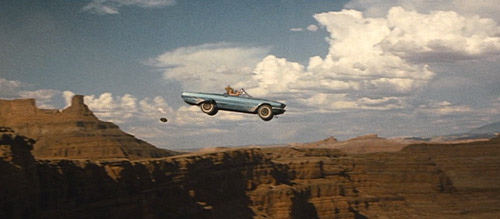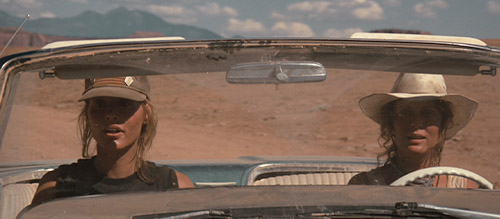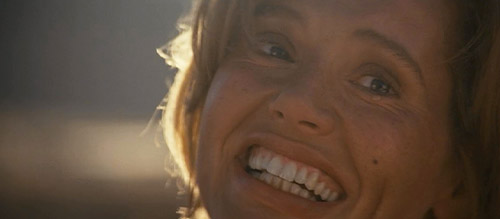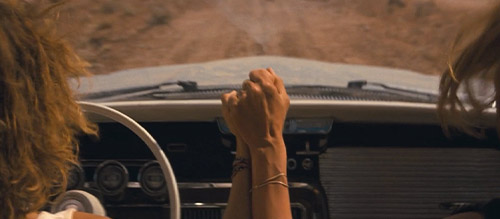Thelma and Louise: The Most Powerful Final Image in Cinema
This article was written exclusively for The Film Magazine by Gala Woolley.
Thelma & Louise is undoubtedly the film that marked my own feminist awakening, and 30 years on it remains iconic and revolutionary in its representation of women on screen. The ending to Thelma & Louise has been described by the American critic Marita Sturken as “both tragic and idealistic at the same time”, and the decision to have Thelma and Louise drive off the cliff in the film’s unforgettable conclusion has divided opinion. In my opinion, the film’s ending remains the most powerful final image in cinema history.
When describing the ending of Thelma & Louise, director Ridley Scott recalled that “it just seemed appropriate that they continue the journey”. The iconic final freeze-frame symbolises the two friends’ freedom, and by ending on them suspended in mid-air, the image immortalises the characters. As Scott suggests, if we each interpret the ending more figuratively than literally, the women do not die but carry on flying. Before they drive off, Thelma even tells Louise, “Let’s not get caught. Let’s keep going”.
The vast expanse of the Grand Canyon represents the pinnacle of Thelma and Louise’s trip. They have reached the highest points of their respective lives and, having transcended their former roles of housewife and waitress, there is nowhere else for them to go but up. As an iconic American landmark of natural beauty, the awe-inspiring canyon viewed against the sky symbolises the ascension of the two women and their literal flight powerfully symbolises their departure.
The conventional Hollywood happy ending invariably presents marriage as woman’s ultimate goal. The films of Walt Disney Animation demonstrate an ingrained insistence upon a ‘happy ending’ equating to living ‘happily ever after’ with a man. Film writer Edward Ross claims that “from Snow White and the Seven Dwarfs to Beauty and the Beast and beyond, Disney has long characterised its female characters as damsels in need of rescue, for whom marriage is the ultimate goal”. As the first Disney animation, Snow White established the theme of the ‘marriage goal’, beginning a troubling trend that future Disney films would follow. One of the main songs in the film is “Someday My Prince Will Come”, and Snow White continually fantasises about how “then he will carry me away to his castle, where we will live happily ever after”. Snow White literally sits and waits for a romantic partner, dreaming about the day she will finally find happiness within the arms of a man. The film ends with her prince waking and rescuing her, before lifting her onto a white horse, essentially parodying the definition of a ‘fairy tale’, as the prince and princess ride off to a golden palace in the distance. There is literal narrative closure as we are shown the last page of a book that reads “and they lived happily ever after”.
Thelma & Louise is subversive not only in its refusal to conform to patriarchal conventions, but also in its lack of closure. Whereas conventional Hollywood endings encourage us to imagine a life beyond the image, as seen with Snow White and her prince, Thelma & Louise encourages us not to envisage what happens beyond the freeze-frame. With the final shot, we are left with a positive and uplifting image of Thelma and Louise flying through the sky. If their story ends when the film does, they do not die, but are immortalised in that moment, ascending from the world below.
Screenwriter Callie Khouri has since stated that “after all they had been through [she] didn’t want anything to be able to touch them”. By driving off the cliff, the pair escape the confines of the world. As Khouri intended, they are untouchable in their flight. Film critic Manohla Dargis suggests that the final destination of Thelma and Louise is ultimately irrelevant when compared to the strength of their friendship. Dargis contends that “no matter where their trip finally ends, Thelma and Louise have reinvented sisterhood for the American screen”. Again, this idea encourages each of us to not prioritise the coming deaths of the protagonists but to acknowledge the greater importance of the characters’ lives and friendship. The final gaze in the film is at each other, as they smile in mutual exhilaration.
The lyrics of Glenn Frey’s “Part of Me, Part of You” illustrate the essential message of the film, which is about friendship and loyalty. The line: “you and I will always be together, from this day on you’ll never walk alone”, evokes the inseparability of Thelma and Louise. Frey’s lines reflect the “tragic but idealistic” tone of the film referred to by Marita Sturken, as the women end their journey but achieve an unbreakable bond of friendship.
Though Thelma & Louise does not have a typical fairy tale ending, it draws on the ‘happy ending’ idea, albeit unconventionally by freeing its protagonists from patriarchal society. It is an adult fairy tale insofar as it eschews the naivety of the type of happy ending that involves marrying a prince. The refusal of the characters to submit to patriarchy within the narrative is simultaneously reflected in its unconventional ending.
With their deaths not being shown, the pair are effectively mythologised. American author Laura Shapiro describes the ending as being about “two women whose clasped hands are their most powerful weapon”. They are not violent in their final decision, but nor are they defeatist.
Thelma & Louise shatters expectations of a Hollywood happy ending. It diverges from the patriarchal definition, exchanging heteronormative union for liberation and platonic companionship. Scott’s protagonists pursue their own destinies and ultimately rescue themselves. Thelma & Louise is therefore subversive not only in its refusal to conform to patriarchal conventions, but also in its lack of closure, as its one final still image leaves us with an impossible ‘forever’.
Written by Gala Woolley
Laura Shapiro, “Women who kill too much” in Newsweek, 1991.
Gala Woolley, “The Road to Female Empowerment: Resisting Gender Conventions of Hollywood Cinema in Thelma & Louise.”
You can support Gala Woolley in the following places:
Twitter – @GalaWoolley
Blog – screenqueens.co.uk





